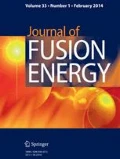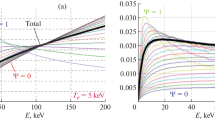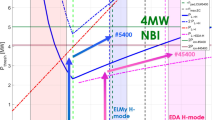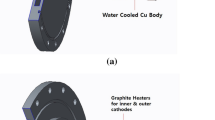Abstract
We describe the synthetic diagnostics (SD) of the preliminary design of divertor neutron flux monitor (DNFM) dedicated for simulations of the neutron flux measurements in ITER. It is based on the technique developed for fast simulation of plasma evolution keeping the accuracy of comprehensive 3D Monte Carlo simulations. The developed technique is also applicable to simulations of diagnostics signals for a range of neutron and optical diagnostics in tokamak plasmas and enables fast simulations of the local radiation fields and diagnostic signals for arbitrarily distributed volumetric sources. The capabilities of the DNFM SD are demonstrated for simulations of the ITER baseline scenario.
















Similar content being viewed by others
References
A.R. Polevoi, et al., Fast simulation of local radiation fields for synthetic diagnostics, in 45th EPS Conference on Plasma Physics, July 2–6, Prague, Check Republic, http://ocs.ciemat.es/EPS2018PAP/pdf/P4.1009.pdf
YuA Kaschuck et al., Divertor neutron flux monitor: conceptual design and calibration. AIP Conf. Proc. 988, 303 (2008)
G. Mckinney, MCNP6 User’s Manual, Report number: LA-CP-13-00634, LANL (2013)
D.A. Brown et al., ENDF/B-VIII.0: the 8th major release of the nuclear reaction data library with CIELO-project cross sections, new standards and thermal scattering data. Nucl. Data Sheets 148, 34–37 (2018)
A.R. Polevoi et al., Assessment of neutron emission from DD to DT operation of ITER, P4.126, in 42th EPS Conference on Plasma Physics, Lisbon, Portugal, 22–26 June 2015
E.H.-L. Liu, Fundamental Methods of Numerical Extrapolation with Applications (MIT Open Course Ware, 2006)
Zlatev Zahari et al., Richardson Extrapolation: Practical Aspects and Applications (De Gruyter, Berlin, 2017)
Glenn F. Knoll, Radiation Detection and Measurement, 3rd edn. (Wiley, New York, 2000). ISBN 0-471-07338-5
S. Kajita et al., Contrib. Plasma Phys. (2016). https://doi.org/10.1002/ctpp.201500124
F. Imbeaux et al., Nucl. Fusion 55, 123006 (2015)
Funding
Development, pilot production, testing and preparation for delivery of special equipment to ensure the fulfillment of Russian obligations under the ITER project in 2017 (State contract No. 4A.241.9 B. 17.1001) and 2018 (State contract No. 4A.241.19.18.1027).
Author information
Authors and Affiliations
Corresponding author
Additional information
Publisher's Note
Springer Nature remains neutral with regard to jurisdictional claims in published maps and institutional affiliations.
Disclaimer: ITER is the Nuclear Facility INB no. 174. The views and opinions expressed herein do not necessarily reflect those of the ITER Organization and the Institution “Project Center ITER”. The work was performed in accordance with the state contracts dated 31.01.2017 No. N. 4A.241.9 B. 17.1001, dated 19.04.2018 N. 4A.241.19.18.1027 “Development, pilot production, testing and preparation for delivery of special equipment to ensure the fulfillment of Russian obligations under the ITER project in 2017 and 2018 » .
Appendix
Appendix
The real detectors of the DNFM produce signals, which are affected by different factors such as scattering, reflection, absorption of neutrons by plant elements, etc. Calculation of such complicated transformation of a signal into a measurement quantity typically requires time-consuming simulations by Monte-Carlo codes. In our particular case, the MCNP code [3] is typically used for computation of the neutron fluxes from the neutron radiation field.
The computational MCNP model for our studies is the C-Lite model of the ITER tokamak with ring unit sources of neutrons. The ITER C-Lite model is a CAD based model converted using the SuperMC program into MCNP format. We have used the weight-window MCNP feature to reduce computational time for our studies. The weight-window input file is generated using the volumetric plasma source before running the calculations with ring unit sources. Application of the weight-window feature reduces our computational time costs by a factor of ~ 50.
One task of Green’s function Gdij simulation in the convertors of the DNFM detectors takes about 15 h of computational time on 8 CPUs to achieve a 10% precision in each energy group (41 energy groups in total) with the weight-window generator feature of MCNP.
Figure 2 illustrates the “zones of direct exposure” of the detectors. These are the zones, where the DNFM detectors are exposed to the neutron sources directly without any obstacles. This effect is more important for the fission rate of detectors with U-238 because that type of uranium is much more sensitive to the high energy part of neutron spectrum (En > 1 MeV) than to the resonance and thermal neutron energies, which is typical of U-235. The cross-section of the neutron induced fission reaction with U-238 in resonance and with thermal neutrons is ~ 105 times smaller than that for fast neutrons [4]. Meanwhile for the U-235 cells the largest contribution to the fission rate comes from the slowest part of the spectrum (Fig. 3). Therefore, it is necessary to analyze the sensitivity of the results to the number of energy groups used in the MCNP simulations. To check this sensitivity we have compared the simulations of the signal from a unit source located near the plasma center, i.e. close to the neutron source maximum, (R, Z) = (6, 0.5) m, for 82 and 41 energy groups. The difference in the signals simulated with 41 and 82 energy groups appears to be within the statistical error of 2% for all types of DNFM FCs. Therefore, we can conclude that the inclusion of 41 energy groups is sufficient and preferable, since the use of 41 energy groups provides faster convergence and meet the required accuracy of the simulations.
To keep an acceptable accuracy of simulations of the signal at the location of a detector, the choice of the reference spatial grid should also take into account the dependence of the contribution to the signal on the distance to the radiating ring, and the plasma shape evolution. The most time consuming part of the GFRF method is the precomputing of detector signals from ring unit sources using the Monte-Carlo method, which is used for simulations of the basic matrix for the Green’s function. To ensure that the spatial grid step chosen for the simulations is optimal we have applied the Richardson extrapolation scheme to optimize the number of grid nodes and to estimate the quality of our Green functions. The Richardson extrapolation scheme increases the precision of the results for a given number of grid points and enables the choice of the optimal grid size. We proceed with the general description of the scheme following the notations of Ref. [6].
We assume an that the approximation A(h) of some function A provides an approximation with a residual term of O(hk) (Eq. 12) [6], where h is a parameter characterizing the “coarseness” of the problem discretization. In our case h is the distance between adjacent grid nodes. In that case, we can obtain better estimation B(h), taking into account several sequential approximations for decreasing h. We have followed the Richardson extrapolation scheme to determine the Green’s function for the fission rates. The results of the fission rate in DNFM detectors from the standard volumetric plasma source was taken as the ideal value A.
According to [7] using recursive formulas of the Richardson scheme in Eqs. 13 and 14, as illustrated in Table 2, we can obtain Br(h) which is a better approximation to function A. We begin the computations by the initial condition r = 0 where on each step i we compute the initial approximations A(hi) taking input grids with different step size hi= h0/2i−1. After the range of steps has been explored up to high values of i, the parameter r is increased by one and the algorithm computes the Richardson extrapolation functions Br(hi) using the approximations from the previous step in r. These recursive method is stopped when the relative deviation O(hk)/A does not decrease or starts to increase with further reduction of h.
where r is the order of Richardson extrapolation term; k is the power of Richardson extrapolation residual term.
The accuracy of the Richardson extrapolation scheme used was estimated by comparing the values of the neutron flux density Ф and fission rate Rf in the DNFM detectors computed by GFRF method with the results of the MCNP simulations from the volumetric plasma source (C-Lite). The contribution of an arbitrarily distributed volumetric source of radiation with intensity S = S(R, Z) to the flux density or fission rate at the location of the detector was calculated using Eq. 15.
In our case we have optimized the chosen spatial grid for plasma shape and source distribution at the stationary burn phase using \(G_{d} \approx G_{d}^{h}\), where \(G_{d}^{h}\) is the analytical interpolation of the Green’s function Gij calculated on the equidistant rectangular grid Ri, Zj with step size h:
The results of the implemented Richardson extrapolation scheme are illustrated in Fig. 17. The starting grid step was chosen to be h0= 1 m. The power of residual term k = 2 (Fig. 17a) is found from the minimum of O(hk)/A for the least Richardson extrapolation term B3(h), which corresponds to the optimal step size of the basic grid, h = h0/2 = 50 cm for the DNFM case (Fig. 17b).
The relative deviation of results with this optimum choice for the GFRF method does not exceed 2% (see Table 3).
Rights and permissions
About this article
Cite this article
Kovalev, A.O., Polevoi, A.R., Polunovskiy, E.I. et al. Simulations of Fusion Power Measurements by Monitors of Neutron Flux in Evolving ITER Plasma. J Fusion Energ 39, 40–52 (2020). https://doi.org/10.1007/s10894-020-00232-x
Published:
Issue Date:
DOI: https://doi.org/10.1007/s10894-020-00232-x





